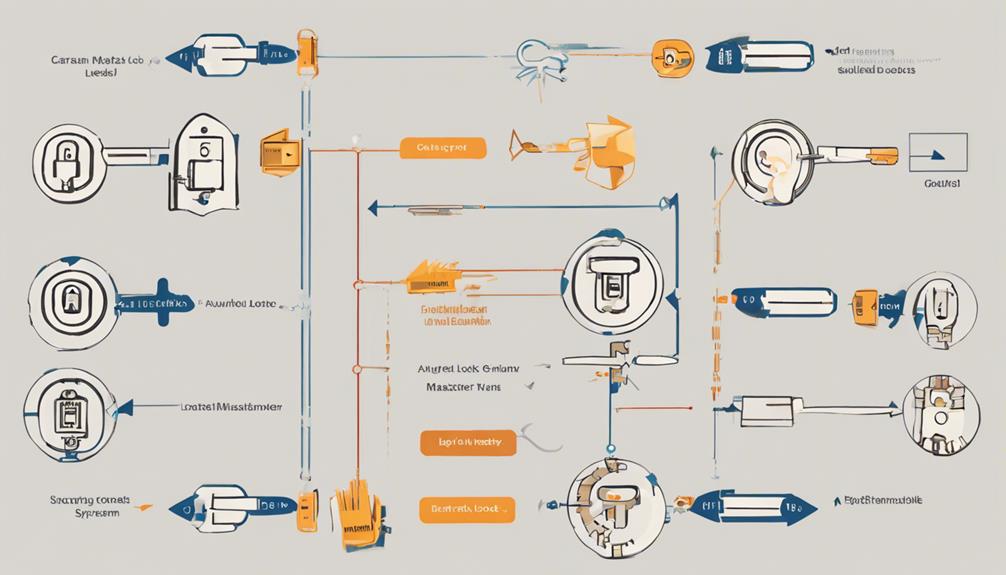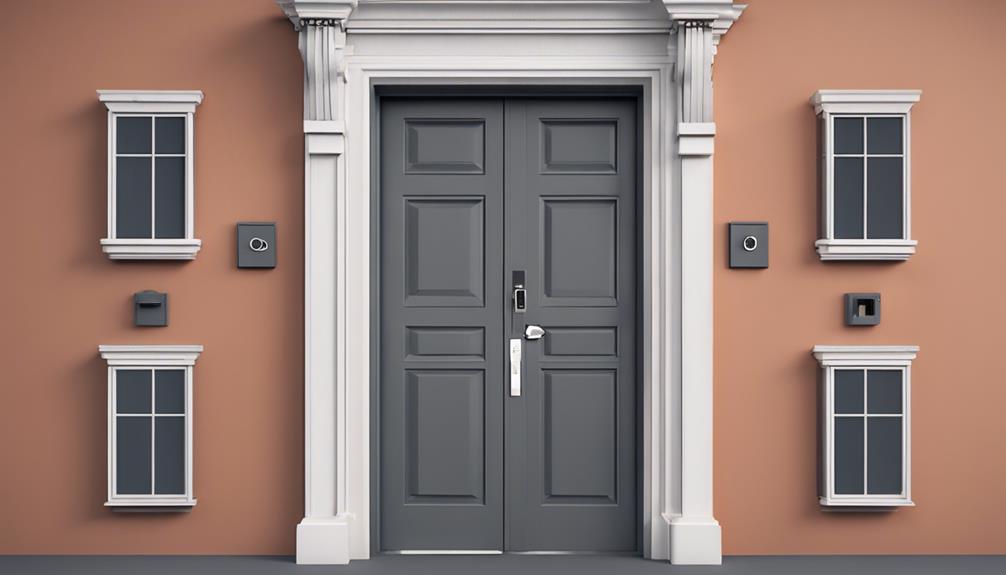In a master key system, a single key allows access to multiple locks, offering tailored levels of entry and advanced security measures. This system streamlines access control by assigning individual keys for specific locks while a master key can operate all locks. It simplifies key management, reducing the need for multiple keys and ensuring organized security protocols within your premises. If you seek an extensive understanding of master key hierarchies, benefits, and installation processes, further insights await for a deeper grasp of optimizing access control mechanisms for your specific needs.
Key Takeaways
- Master key opens all locks, while individual keys are specific to designated locks.
- Reduces key burden by using fewer keys for multiple locks.
- Enhances security with organized access control.
- Provides customizable access levels for individuals or groups.
- Simplifies key management and maintenance processes.
Understanding Master Key Systems

When it comes to enhancing the security of a building or a facility, understanding the intricacies of a Master Key System is essential. One of the key benefits of a master key system is the ability to customize access levels for different individuals or groups. This customization allows you to control who can access specific areas within a building, ensuring maximum security. Imagine being able to grant access to certain rooms to employees while restricting entry for visitors or contractors. With a master key system, this level of control is achievable. The flexibility and convenience offered by system customization make managing access a breeze. To further explore the advantages of master key systems, check out Unlocking Convenience and Security With Master Key Systems. Stay tuned to discover how this system works in more detail!
How a Master Key System Works
A Master Key System operates by assigning each lock within a building or facility a specific key that corresponds to it. This clever setup allows for efficient key management and access control. Imagine this: you have a grand building with multiple rooms, each needing its own key. Instead of carrying a massive keychain resembling janitor keys, a master key system simplifies things. With this system, you can have a master key that opens all locks, while individual keys only work in their designated locks. It's like having a VIP pass that gets you into every room, while others have access to specific areas only. This method guarantees security and streamlines access, making life a whole lot easier for everyone involved.
Benefits of Master Key Systems

Utilizing a Master Key System offers a multitude of benefits for efficient access control and key management in various settings. Master keying is a versatile solution that allows for the creation of hierarchical access levels, providing enhanced security features without the need for multiple keys. Here are some reasons why you should consider implementing one:
- Cost Considerations: Save money by reducing the number of keys needed and enhancing security without breaking the bank.
- Maintenance Requirements: Simplify key management processes and reduce the time and effort required for maintenance tasks.
- Efficiency Boost: Streamline access control by granting different levels of access to individuals with a single key, making daily operations smoother and more secure.
These benefits make Master Key Systems a smart choice for those looking to enhance security while minimizing costs and maintenance efforts.
Types of Master Key Systems
When it comes to types of master key systems, understanding keying options, system hierarchy, and security levels is vital. Keying options refer to how keys are cut and configured to open specific locks within the system. System hierarchy determines the structure and organization of key levels within the system, while security levels dictate the extent of access each keyholder has. Additionally, it is essential to take into account rekeying and security considerations when implementing a master key system.
Keying Options
Master Key Systems offer various keying options that cater to different security needs and organizational structures. When it comes to keying options, you have a few choices to evaluate:
- Standard Master Key System: This system allows one key (master key) to access all locks within the system, while each lock also has its unique key.
- Grand Master Key System: With this system, you have multiple master keys that can access different groups of locks. A grand master key sits at the top, controlling all locks.
- Master Keyed Different System: In this setup, each lock has its unique key, but a master key can access multiple locks within a specific group.
Choose the keying option that suits your needs and keeps your spaces secure yet accessible!
System Hierarchy
To understand the hierarchy of System Key Systems, it is crucial to grasp how different levels of access are structured within these systems. Key management plays a significant role in controlling who can access which areas. Access control is at the heart of this system, determining who holds the keys to the kingdom, quite literally! Below is a simple breakdown of the types of Master Key Systems:
| System Type | Description |
|---|---|
| Standard Key System | Basic access for individual locks |
| Sub-Master Key System | Intermediate level with broader access |
| Master Key System | Top-level access, control over all locks |
Understanding this hierarchy is key to effective key management and maintaining secure access control.
Security Levels
At the core of Master Key Systems are distinct security levels that dictate access control. These security levels play a vital role in determining who can access which areas within a building or facility. Here are the key types of security levels in Master Key Systems:
- Grand Master Key: This key grants access to all areas within a system, making it the most powerful key in the hierarchy.
- Master Key: Operating below the Grand Master Key, this key provides access to a specific set of locks, allowing flexibility in access control.
- Change Key: These keys offer access to individual locks only, ensuring a more restricted level of access control within the system.
Understanding these security protocols is essential for effective access control management.
Two-Level Master Key Systems

Two-Level Master Key Systems offer dual-access control levels, providing enhanced security features for restricted areas within a facility. With this system, different keys can grant varying levels of access, allowing for a more tailored approach to security management. By implementing Two-Level Master Key Systems, organizations can guarantee that sensitive areas are adequately protected while still allowing authorized personnel to navigate through designated zones efficiently. Additionally, these systems can be integrated with advanced key management solutions to track key usage and maintain a secure environment for key control and monitoring.
Dual-Access Control Levels
When implementing a Dual-Access Control Level, also known as a Two-Level Master Key System, the approach involves a sophisticated hierarchy of keys that grant different levels of access within a building or facility. This system allows for a fun mix of security and convenience, ensuring that the right people have access to the right places at the right times. Here are three key aspects of Dual-Access Control Levels:
- Custom Access Permissions: You get to play the role of the gatekeeper, deciding who can access certain areas based on their clearance level. With the added benefit of Master Keying: Simplifying Access for Multiple Users, the system becomes even more versatile.
- User Roles Galore: From basic users to top-tier admins, each key corresponds to a specific user role, making sure everyone stays in their lane.
- Flexibility at Its Finest: Need to change access levels? No problem! This system allows for easy adjustments on the fly.
Enhanced Security Features
Enhancing security features in a Two-Level Master Key System involves integrating advanced mechanisms that fortify access control measures within a facility. This system provides an added layer of security by allowing key management at different access levels. Imagine this: lower-level keys can open specific doors, while higher-level keys grant access to multiple areas. It's like having a VIP pass that lets you cruise through the entire venue while others are stuck in line. This setup not only enhances security but also simplifies access control for authorized personnel. With this two-level approach, you can guarantee that only the right people have access to restricted areas, making it a key player in maintaining a secure environment.
Three-Level Master Key Systems
To explore Three-Level Master Key Systems, it is essential to understand the intricate hierarchy that governs access control within a structure. In a three-level design, each key operates at a different tier, offering varying levels of access to different users. Here's how it works:
- Grandmaster Key: This key can open all doors within the system, providing unrestricted access.
- Master Key: These keys are one level below the grandmaster key and can open a specific set of doors.
- Submaster Key: Operating at the lowest level, these keys grant access to a limited number of doors, usually within a defined area.
This hierarchical access approach guarantees flexibility and security tailored to different user needs.
Designing and Installing Master Key Systems

Moving from the concept of Three-Level Master Key Systems, the process of designing and installing Master Key Systems involves a meticulous approach to guarantee seamless access control. When diving into master key design, it's vital to map out key hierarchies, considering individual access needs alongside overarching system security. The installation process is where the magic happens – keys are cut, locks are configured, and cylinders are meticulously aligned to ascertain smooth operation. Attention to detail is key; one misstep could result in a comedy of errors, leaving you locked out of your own kingdom. So, whether you're a master key maestro or a novice in the world of access control, remember – precision in design and finesse in installation are the keys to a perfectly orchestrated system.
Conclusion
In summary, a master key system offers unparalleled convenience and security for managing access control. With the ability to open multiple doors with just one key, you can streamline your key management and enhance your overall security measures. So, if you're ready to take your security to the next level, consider implementing a master key system. It's like having a secret weapon in your arsenal, giving you peace of mind and control over your space.









